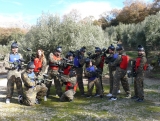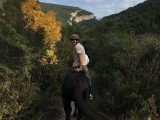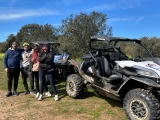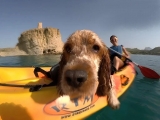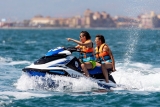After completing the first part of warm-up and training exercises, it's time to get accustomed to the snow.
Self-teaching isn't advisable, despite the undeniable economic advantages, because it leads to fundamental mistakes that will inevitably hinder progress in more advanced stages.
Follow each exercise's instructions precisely and pay attention to the most common errors. The ideal is to practice snowboarding accompanied by someone who can spot your flaws, allowing timely corrections.

The Learning Progression
The simplicity of learning snowboarding has undoubtedly contributed to its great success. The instinctive nature of the movements significantly facilitates approaching this activity. Our exercises aim to help future snowboarders control their board with confidence, using natural and elegant movements while avoiding unnecessary tension. Therefore, special attention must be paid to body position and movements.
An important recommendation is caution: always maintain a wide safety margin, especially during early learning phases, by limiting speed. Speed should always correspond to your control ability to avoid endangering yourself or others.
Progression Phases
This programme consists of exercise sequences that will gradually help you acquire snowboarding technique - from first turns to initial diagonal descents, progressing to faster turns and eventually freestyle.
1. Initial Awareness
Your first snowboard experience should be as untraumatic as possible. Begin with exercises where you have one foot fixed to the board and the other free - this technique teaches the initial movements.
2. Weight on the Edge
The first exercise teaches transferring weight from one edge to the other. Position yourself on a nearly flat slope. With your front foot secured, step forward; this transfers weight to the boot's toe and board's toe edge. Conversely, stepping backward shifts weight to your heels and the board's heel edge.
In this same position, make endless movements with your free leg for better sensitivity: foot forward, backward, crossed forward, crossed backward, foot on the board's centre. After slow initial changes, try making the board slide short distances forward/backward while keeping it on one edge, performing movements as fluidly as possible.
3. Basic Push-Step
The basic push-step enables initial board movements and remains useful at higher skill levels. Without poles or snowshoe weight, we use the push-step to cross flat sections. This resembles ice-skating propulsion and initially helps sensitise the lower limb which guides the board.
Find a spacious, flat area, secure your front foot on the board, and place your rear foot just behind the heel edge. Now give yourself a small push with the free foot, ensuring the board stays flat while letting edges glide. Repeat this while moving rhythmically in circles, figure-eights and diagonals.

Even after reviewing snow techniques, we strongly recommend beginning with professional instruction to avoid unnecessary risks. After these basic initiation exercises, you can progress to activities that improve your winter sport skills:
Uphill Step
Used for climbing short slopes. Push off your toes to ascend. Find a gentle incline, secure your front boot, and position the board perpendicular to the fall line to prevent downward sliding.
Climb by moving your free foot upward, then lift and place the board beside it. The goal is advancing with maximum composure to achieve balance.
Direction Change with Locked Feet
You must learn to rise on both toes and heels - here's how to turn around:
- Heels to Toes. A classic beginner move: with your back against the snow, rotate the board 180° relative to your body's axis, then align your torso with the new board position. The challenge is the board limiting rotation.
- Toes to Heels. The reverse movement. You'll notice difficulty due to the board's size.
How to Get Up
Falling is snowboarding's first learning phase. Like in sliding sports, frequent falls occur - you must learn to rise effortlessly in any situation with minimal energy expenditure.
- Rising on Toes. From kneeling, bring knees near hands and push up to straighten your legs. Use leg strength primarily to avoid tiring arms - steeper slopes make this easier.
- Rising on Heels. More challenging than toe-rising. From sitting, bring heels near buttocks, push up with arms, lift pelvis, and align your body vertically with the heel edge raised. Maintain edge grip. Here, steeper slopes reduce difficulty.
Fundamental Position
The basic snowboarding stance: flexed ankles/knees, straight torso looking forward, shoulders aligned over hips. Identical with both feet secured. Always practice perpendicular to the fall line on both edges.
- Straight Descent (One Foot). With board perpendicular to fall line in fundamental position, make small jumps to flatten the board on the steepest slope, sliding until stopped by terrain or falling sideways. Repeat while maintaining proper stance. Practice ankle/knee flexion-extension to feel sole pressure.
- Diagonals (One Foot). Maintaining fundamental position, angle the nose slightly downhill and slide slowly on both edges until stopping. Equal leg flexion/pressure is crucial for proper edge grip.

Toe Turn
Begin practicing turns. From fundamental position, push off your toes with a small jump to the fall line, applying slight pressure to your front leg and toes.
Look toward your turning direction and slightly shift your front shoulder accordingly, pivoting on your front leg while maintaining clean toe edge contact. Keep facing downhill with toe pressure.
Heel Turn (One Foot)
Similar but harder to learn as heel edges offer less feedback. Position perpendicular to slope, jump slightly into straight descent with extra front-leg flexion and heel edge pressure.
Look toward your turn direction and slightly move your shoulder accordingly while maintaining heel pressure through knee/ankle flexion.
Finish perpendicular to the fall line on your heel edge, facing away from the mountain. Practice both turns repeatedly until mastered.
Diagonals
Practice heel/toe diagonals as with one free foot, but now focus on equal foot pressure since both feet are secured. Practice flexion/extension throughout.

Basic Toe Turn
From straight descent position, apply slight toe edge pressure (especially front foot), turn your head toward the turn direction, and slightly tuck your front shoulder. Maintain equal leg pressure to keep the toe edge engaged without skidding - successful execution leaves clean lines in snow.
Basic Heel Turn
From straight descent with strong flexion, turn your head toward the heels while maintaining heel pressure (especially front leg).
Slightly tuck your shoulder to increase heel edge grip, continuing the turn until facing away from the mountain. Practice both basic turns repeatedly to gain control.






